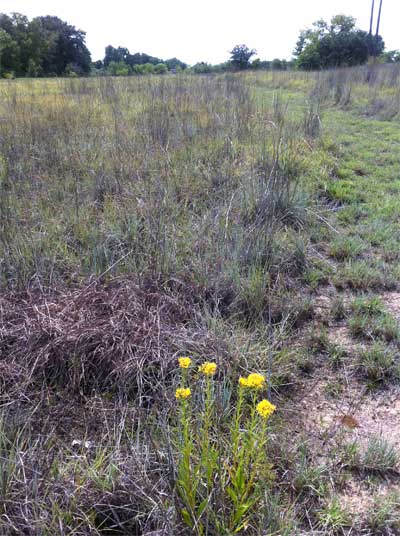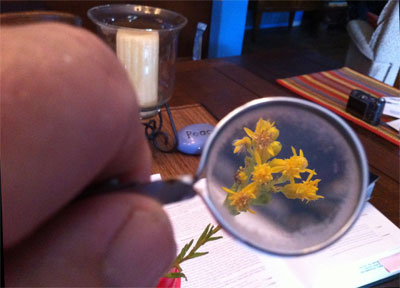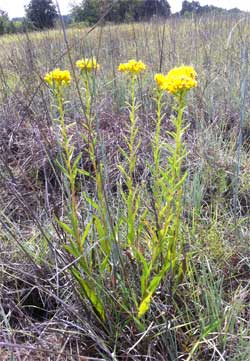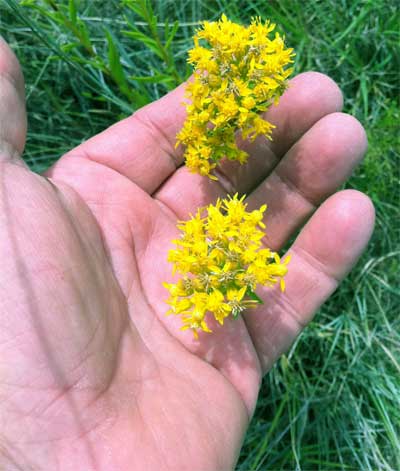Native Son – August, 2012
Lessons From a Goldenrod
As I was gathering eggs from the nest boxes today, a wind shift suddenly blew into the henhouse. Such a small thing, but it was enough to make me think that maybe I needed a little shift as well. My meadow has gone unexplored for most of the summer. I figured she forgave me for not walking through the grasses the past month or two, because she knew how parched and sun-baked I was through the dog days. An inch or two of rain and some cool breezes have revived me … maybe she is showing signs of life again as well.
The grasses and pallid yuccas have responded well to the moisture, and greened up noticeably within the last few days, particularly the little bluestem. But the forbs are nowhere to be seen. The annual and perennial wildflowers are simply non-existent, shriveled into nothingness by the brutal Texas summer. The Engelmann daisies, the white milkworts, the Indian blankets — even the Illinois bundleflowers — all gone. Perhaps they were grazed off by the hordes of grasshoppers that explode up from the ground with each step I take. Perhaps they simply dried up and crumbled. Perhaps….

The only floral color in sight. All photos by Steven Chamblee.
I stop mid-thought, mouth agape at the sight in front of me. A single plant, crowned with golden-yellow flowers shines like a lighthouse beacon some 50 feet away. I stop and scan the nearby area … not another bit of floral color in sight. I walk over to this little jewel, and bend down to examine her flowers. Truthfully, I’m not sure what it is. Shakespeare rises in the back of my mind, “What’s in a name? That which we call a rose by any other name would smell as sweet.” Hmmm … does it really matter what her name is, what some taxonomist named her 150 years ago? What really matters is that she is here now, alive in this meadow. She alone lived right through the heat and drought. She alone fought the struggle and survived. Scientifically and spiritually, she is my “Flora Extant!”
This little tickle of victory quickly fades as my mind begins to anthropomorphize this little flower and her situation. She is alone. She has no friends or family within sight, and her future is uncertain. I sit down in the crunchy grass to remember all of the times when I walked this meadow by myself, heartsick and saddened by loneliness. Loneliness can cripple the rational mind, making one feel worthless, meaningless, and destined for a wasted future. I know that all too well. I have been there myself. But … I also survived. I survived being lonely … survived being broke and sad and desperate. A tear rolls down my cheek as I cup this delicate-looking little flower. She is far tougher than she looks, and her lessons are clear to me … you are worthy of the gift of life … you are stronger than you know … just keep breathing. The drought will break one day, and the rains will fall and the meadow will once again blossom like a rainbow. Life will be beautiful, but we have to endure the drought to see it. The Bard speaks to me again, “One touch of nature makes the whole world kin.”

Steven closely examines the flower in search of the defining characteristics.

The brilliant golden yellow blossoms of flat-topped goldenrod (Solidago nitida).
Soon enough, I am heading for the house with a dozen beautiful eggs cradled in the kangaroo pouch of my shirt (just lift up your shirt tail … instant pouch!) and a small sample of the flower dangling from my teeth. A quick zip through Geyata’s wildflower book leads me to three viable options to identify my little survivor, and all three are, predictably, in the aster family. I delve a little deeper by hitting the good ole BRIT book (Illustrated Flora of North Central Texas). Senecios are spring bloomers, so they’re out. Euthamias have gland-dotted leaves, so they’re out. So I’m down to Solidago, the goldenrods. Most have elaborate panicles of flowers, so this distinctive little flat-topped inflorescence leads me to Solidago nitida, more commonly called … well, what do you know…”flat-topped goldenrod.”
So what can be said about goldenrod? First and foremost, goldenrod is NOT the source of your fall allergies. Never mind what your great grandmother told you about goldenrod (but she was probably right about everything else) or how Ricky Ricardo had a goldenrod attack on that episode of I Love Lucy; it just isn’t so. Goldenrods are insect-pollinated (not wind-pollinated), and don’t produce significant amounts of wind-borne pollen. What is really happening when you are having sneezing fits is that you are seeing the bright yellow goldenrod blooming, but you are not seeing the billowing clouds of nearly invisible, airborne ragweed pollen. For centuries, people naturally (though incorrectly) identified those beautiful golden blossoms as the actual cause of their hay fever. This led to people mowing down or killing untold millions of goldenrod plants, which is especially tragic when one realizes that goldenrods are extremely important nectar plants for a wide range of insect species, including Monarch butterflies.

Steven gently cradles the blossoms in the meadow.
There are about 80 different goldenrod species across North America, including about 18 here in North Central Texas. They adorn prairies and roadsides from Mexico to central Canada, and have been used for centuries by Native Americans to make natural dyes … and medicines — which brings me back to my lonely little flower in the meadow, and the lessons she is trying to teach me. The older I get, the more I find the lines between hard science and Mother Nature’s teachings are indeed blurred. Like today, when I listen to a flower and she tells me all will be well … and then I find out her scientific name, Solidago, literally means “to make whole.”
About the author: Steven Chamblee is the chief horticulturist for Chandor Gardens in Weatherford and a regular contributor to Neil Sperry’s GARDENS magazine and e-gardens newsletter. Steven adds these notes:
The rains have fallen and Chandor Gardens is basking in the luxurious growth and color that is fall. Come and see the blankets of morning glories, the second-season roses, and the autumn-blooming azaleas. Visit on a Tuesday and enjoy a splendid lunch by The Wild Mushroom. Make plans to attend the magnificent evening of chamber music by The Hall Ensemble on Oct. 16 (reserve now, as this event will sell out early). Visit www.chandorgardens.com for all the details, or call 817-613-1700. Then just take I-20 west to exit 409, hang a right, go 2.1 miles and hang a left on Lee Avenue. Head straight 12 blocks and you’re driving in the gates. Call 817-361-1700 for more information. You can always go to www.chandorgardens.com for a picture tour and details.
I can always use another road trip! Let me know if you’d like me to come out and speak to your group sometime. I’m low-maintenance, flexible, and you know I like to go just about anywhere. No city too big; no town too small. Just send me an e-mail at schamblee@weatherfordtx.gov and we’ll work something out.

